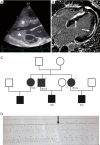Hypertrophic cardiomyopathy: genetics and clinical perspectives
- PMID: 31737545
- PMCID: PMC6837941
- DOI: 10.21037/cdt.2019.02.01
Hypertrophic cardiomyopathy: genetics and clinical perspectives
Abstract
Hypertrophic cardiomyopathy (HCM) is the most common inherited heart disease and defined by unexplained isolated progressive myocardial hypertrophy, systolic and diastolic ventricular dysfunction, arrhythmias, sudden cardiac death and histopathologic changes, such as myocyte disarray and myocardial fibrosis. Mutations in genes encoding for proteins of the contractile apparatus of the cardiomyocyte, such as β-myosin heavy chain and myosin binding protein C, have been identified as cause of the disease. Disease is caused by altered biophysical properties of the cardiomyocyte, disturbed calcium handling, and abnormal cellular metabolism. Mutations in sarcomere genes can also activate other signaling pathways via transcriptional activation and can influence non-cardiac cells, such as fibroblasts. Additional environmental, genetic and epigenetic factors result in heterogeneous disease expression. The clinical course of the disease varies greatly with some patients presenting during childhood while others remain asymptomatic until late in life. Patients can present with either heart failure symptoms or the first symptom can be sudden death due to malignant ventricular arrhythmias. The morphological and pathological heterogeneity results in prognosis uncertainty and makes patient management challenging. Current standard therapeutic measures include the prevention of sudden death by prohibition of competitive sport participation and the implantation of cardioverter-defibrillators if indicated, as well as symptomatic heart failure therapies or cardiac transplantation. There exists no causal therapy for this monogenic autosomal-dominant inherited disorder, so that the focus of current management is on early identification of asymptomatic patients at risk through molecular diagnostic and clinical cascade screening of family members, optimal sudden death risk stratification, and timely initiation of preventative therapies to avoid disease progression to the irreversible adverse myocardial remodeling stage. Genetic diagnosis allowing identification of asymptomatic affected patients prior to clinical disease onset, new imaging technologies, and the establishment of international guidelines have optimized treatment and sudden death risk stratification lowering mortality dramatically within the last decade. However, a thorough understanding of underlying disease pathogenesis, regular clinical follow-up, family counseling, and preventative treatment is required to minimize morbidity and mortality of affected patients. This review summarizes current knowledge about molecular genetics and pathogenesis of HCM secondary to mutations in the sarcomere and provides an overview about current evidence and guidelines in clinical patient management. The overview will focus on clinical staging based on disease mechanism allowing timely initiation of preventative measures. An outlook about so far experimental treatments and potential for future therapies will be provided.
Keywords: Hypertrophic cardiomyopathy (HCM); clinical management; molecular genetics; pathogenesis; sudden cardiac death.
2019 Cardiovascular Diagnosis and Therapy. All rights reserved.
Conflict of interest statement
Conflicts of Interest: The author has no conflicts of interest to declare.
Figures





References
-
- Maron BJ, Gardin JM, Flack JM, et al. Prevalence of hypertrophic cardiomyopathy in a general population of young adults. Echocardiographic analysis of 4111 subjects in the CARDIA Study. Coronary Artery Risk Development in (Young) Adults. Circulation 1995;92:785-9. 10.1161/01.CIR.92.4.785 - DOI - PubMed
-
- Braunwald E, Lambrew CT, Rockoff SD, et al. Idiopathic Hypertrophic Subaortic Stenosis. I. A Description of the Disease Based Upon an Analysis of 64 Patients. Circulation 1964;30:SUPPL 4:4-119. - PubMed
-
- Maron BJ, Towbin JA, Thiene G, et al. Contemporary definitions and classification of the cardiomyopathies: an American Heart Association Scientific Statement from the Council on Clinical Cardiology, Heart Failure and Transplantation Committee; Quality of Care and Outcomes Research and Functional Genomics and Translational Biology Interdisciplinary Working Groups; and Council on Epidemiology and Prevention. Circulation 2006;113:1807-16. 10.1161/CIRCULATIONAHA.106.174287 - DOI - PubMed
Publication types
LinkOut - more resources
Full Text Sources
